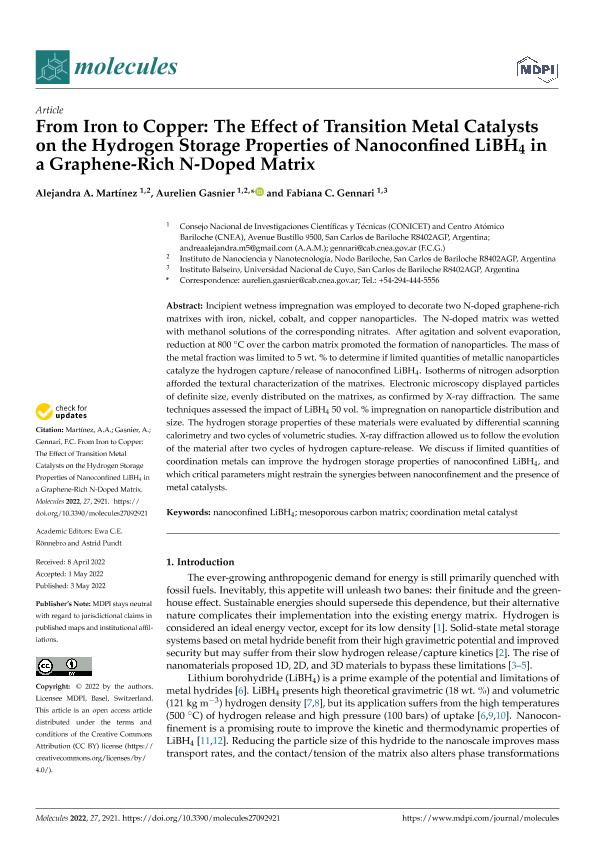Artículo
From Iron to Copper: The Effect of Transition Metal Catalysts on the Hydrogen Storage Properties of Nanoconfined LiBH4 in a Graphene-Rich N-Doped Matrix
Fecha de publicación:
05/2022
Editorial:
Molecular Diversity Preservation International
Revista:
Molecules
ISSN:
1420-3049
Idioma:
Inglés
Tipo de recurso:
Artículo publicado
Clasificación temática:
Resumen
Incipient wetness impregnation was employed to decorate two N-doped graphene-rich matrixes with iron, nickel, cobalt, and copper nanoparticles. The N-doped matrix was wetted with methanol solutions of the corresponding nitrates. After agitation and solvent evaporation, reduction at 800◦C over the carbon matrix promoted the formation of nanoparticles. The mass of the metal fraction was limited to 5 wt. % to determine if limited quantities of metallic nanoparticles catalyze the hydrogen capture/release of nanoconfined LiBH4. Isotherms of nitrogen adsorption afforded the textural characterization of the matrixes. Electronic microscopy displayed particles of definite size, evenly distributed on the matrixes, as confirmed by X-ray diffraction. The same techniques assessed the impact of LiBH4 50 vol. % impregnation on nanoparticle distribution and size. The hydrogen storage properties of these materials were evaluated by differential scanning calorimetry and two cycles of volumetric studies. X-ray diffraction allowed us to follow the evolution of the material after two cycles of hydrogen capture-release. We discuss if limited quantities of coordination metals can improve the hydrogen storage properties of nanoconfined LiBH4, and which critical parameters might restrain the synergies between nanoconfinement and the presence of metal catalysts.
Archivos asociados
Licencia
Identificadores
Colecciones
Articulos (UE-INN - NODO BARILOCHE)
Articulos de UNIDAD EJECUTORA INSTITUTO DE NANOCIENCIA Y NANOTECNOLOGIA - NODO BARILOCHE
Articulos de UNIDAD EJECUTORA INSTITUTO DE NANOCIENCIA Y NANOTECNOLOGIA - NODO BARILOCHE
Articulos(CCT - PATAGONIA NORTE)
Articulos de CTRO.CIENTIFICO TECNOL.CONICET - PATAGONIA NORTE
Articulos de CTRO.CIENTIFICO TECNOL.CONICET - PATAGONIA NORTE
Citación
Martinez, Alejandra Andrea; Gasnier, Aurelien; Gennari, Fabiana Cristina; From Iron to Copper: The Effect of Transition Metal Catalysts on the Hydrogen Storage Properties of Nanoconfined LiBH4 in a Graphene-Rich N-Doped Matrix; Molecular Diversity Preservation International; Molecules; 27; 9; 5-2022; 1-21
Compartir
Altmétricas




